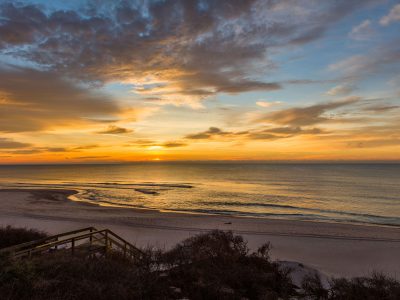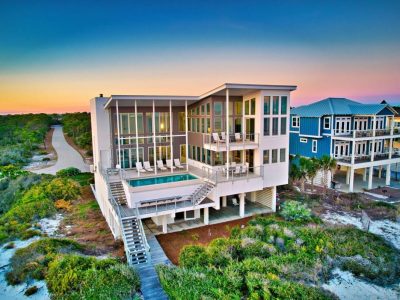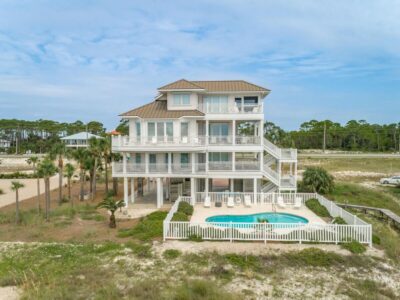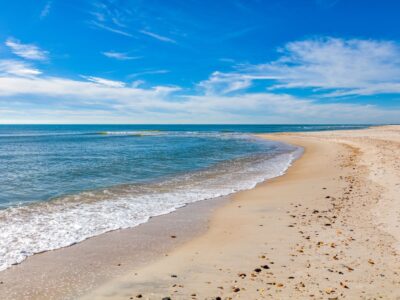
Located between Tallahassee and Panama City on Florida’s Panhandle is one of the state’s hidden gems. St. George Island is an unspoiled paradise, made up primarily of sand dunes with sea oats and pine trees, the landscape is as rich as the island’s history. Just 75 miles west of Tallahassee, and approximately 80 miles east of Panama City, the island is easily reached by bridge from the mainland town of Eastpoint on US 98. St. George is a barrier island 28 miles long and 1 mile wide at its widest point.
Dr. Julian G. Bruce St. George Island State Park occupies 1,883 acres at the east end of the island. The west end of the island is known as the St George Plantation – a gated development of private residences and vacation homes. Today, St. George Island is a haven for those in search of outdoor recreation and exquisite white sand beaches, but it didn’t start out that way.
Early Inhabitants
St. George Island was first inhabited by the Muscogee Creek Indians as early as the 10th century. The arrival of early European colonists in the late 18th century triggered conflict and an intense struggle over the territory, leading to the settlers taking claim over a large tract of land in 1803. The land, including St. George Island, was relinquished to trader John Forbes and Company in an action referred to as the Forbes Grant.
During the early 1800s, the development of trade routes and increased accessibility led to the discovery of plentiful natural resources in the Gulf waters and Apalachicola Bay, like valuable harvests of oysters and crabs. Trading posts emerged along the Forgotten Coast and the Apalachicola River.
As more trade vessels and ships began to make their way through the barrier islands, safe navigation became a concern. The solution came in the form of the Cape St. George Lighthouse, constructed in 1833.
Maritime Trade
In 1846, the 65-foot tower was destroyed by storms, only to be rebuilt two years later on a site just a couple miles away. The second St. George Island Lighthouse stood ten feet taller than the first, incorporating materials from the original lighthouse. It, too, was demolished by a storm a mere three years after its completion. The hurricane that wiped out the second lighthouse was also responsible for the loss of the nearby towers at Cape San Blas and Dog Island.
In 1852, a third lighthouse was installed on St. George Island, where it served as a navigational aid in both war and trade scenarios until it was decommissioned in 1994. In the years that followed, the integrity of the St. George Island Lighthouse was compromised by multiple hurricanes and erosion, resulting in its collapse in 2005.
Thanks to the efforts of the St. George Lighthouse Association and a crew of dedicated volunteers, the lighthouse was once again reconstructed, opening to the public on December 1, 2008. In 2011, the St. George Lighthouse Association also completed reconstruction efforts on the Keeper’s House, adjacent to the 89-foot tower. The building houses the lighthouse museum, visitor center, and gift shop.
To further solidify the expansion of trade routes, the United States Army Corps of Engineers constructed the Bob Sikes Cut In 1954. This man made ship channel separates St. George Island and Little St. George Island, allowing fishing fleets and other seafaring vessels access to the Gulf of Mexico from the bay side.
From Military Training To Tourism
Prior to its part in the expansion of trade and contributions to coastal cuisine, St. George Island also played an important role in aiding our nation’s military measures. In the early to mid-1900s, turpentine from the island’s pine forest was harvested for use in naval stores. As the opportunity to export naval stores expanded, so too did the industry.
Gulf Naval Stores opened on the mainland in Carrabelle, fast becoming a major employer in Franklin County up to World War II, along with area sawmills. During the war, the island was the site of training exercises by troops residing nearby at Camp Gordon Johnston. The completion of a bridge system from the mainland to the island in 1965 helped to facilitate the beginnings of St. George Island’s tourism industry.
Even with modern growth and the island’s increasing appeal as a vacation destination, the quiet gem of the Florida Panhandle remains a place of unspoiled tranquility.
Development on St. George Island is highly regulated by strict building codes designed to preserve the natural beauty of the island. In other words, big-city high rises will never interfere with your spectacular Gulf Coast horizons.
Historic Sites Within A One Hour Drive Of St. George Island
- Cape St George Lighthouse – 2B East Gulf Beach Drive, St. George Island, Florida 32328
- Apalachicola Maritime Museum – 103 Water St, Apalachicola, FL 32320
- Apalachicola National Estuarine Research Reserve – 108 Island Drive – Eastpoint, FL 32328
- Chestnut Street Cemetery – 96 6th St, Apalachicola, FL 32320
- John Gorrie State Museum – 46 6th St, Apalachicola, FL 32320
- Orman House – 177 5th St, Apalachicola, FL 32320
- Raney House Museum – 128 Market St, Apalachicola, FL 32320
- Veterans Memorial Plaza – 230 Market, Apalachicola, FL 32320









